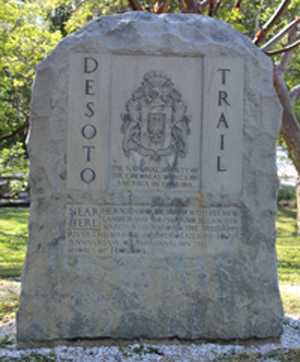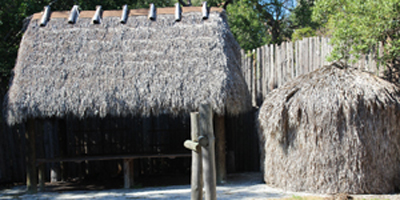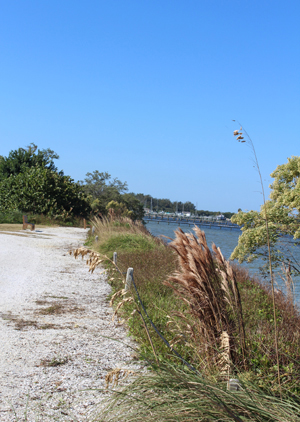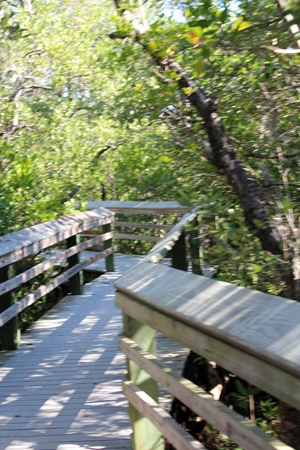
Visitors learn Florida history at De Soto
BRADENTON, Fla. – Hundreds of men wearing armor and bearing swords and shields stepped onto the beach of what is now Bradenton, Fla., almost 500 years ago.
On May 30, 1539, the conquistador Hernando De Soto arrived in La Florida, a land rumored to hold riches and treasure for the taking.
De Soto began his journey of North America with nine ships and more than 620 men; he named his landing spot Espiritu Santo, the Holy Spirit. The religious naming unfortunately did not foreshadow the events to come. The native peoples he met on his journey would be subjected to brutal massacres, kidnapping and coercion.
| Near the entrance of the park, this large, carved rock stands to commemorate the starting point of Hernando De Soto’s expedition that would take him from the shores of Florida’s Gulf Coast to the Mississippi River (Photo by Chelsea Pillsbury). |  |
At the De Soto National Memorial, “The Landing” has been re-enacted for decades. First by the De Soto Historical Society and later, after years of protest from Native Americans in the area, by the De Soto National Memorial rangers themselves.
“The first re-enactments were all about romanticizing and celebrating De Soto. Now we try to give the landing more historical accuracy and we give due respect to the native peoples De Soto and his men brutally killed, captured and pillaged,” said Dan Stevens, a head ranger at the park.
Hernando De Soto is celebrated because he is the first European to see the Mississippi River and to explore the southern United States. The four-year journey that would end with De Soto’s death began in the Tampa Bay area and, because of this on March 11, 1948, the De Soto National Memorial was officially created.
Visitors have the opportunity to try on accurate replicas of armor, watch a film that tracks De Soto on his journey and peruse a collection of books about the De Soto expedition and the area … and that is just inside the Visitor Center.
Outside the Visitor Center, visitors are encouraged to walk the memorial’s nature trail. The trail winds along the shoreline of the park and takes the visitor through a mangrove forest that is much like the one De Soto would have landed in centuries ago.
 |
The living history presentations that are given from December through April in the De Soto National Memorial take place amid a reconstructed camp modeled after what the conquistadors might have built after their landing (Photo by Chelsea Pillsbury). |
Visitors can walk the trails, pack a picnic, and enjoy the beach. Many locals and tourists alike, visit the memorial to engage in bird watching or fishing along the beach. Those with a boat can even anchor their boats in the small, calm cove nestled into the park’s shoreline and swim ashore.
“Actually quite a few of our visitors arrive by boat and may just use the beach for a little tanning and fun,” said Lauren Duncan, another park ranger.
Others, especially locals, take advantage of the nature areas and trails to take their morning walks, either alone or with their dogs by their sides.
“Since entrance to the park is free, during our slower months we get a lot of visitors who just want to appreciate the undeveloped area while they exercise or spend time with their families,” said Misty Harley, a local who volunteers at the park a few times a week.
While these attractions draw visitors to the park all year round, the seasonal activities that the park offers are an even bigger draw.
“Our two main seasons are winter and summer. In winter we have a living history exhibit called Camp Uzita, and in summer our kayak tours bring children and adults to enjoy the weather,” said Ranger Stevens.
| At right, visitors can walk a sandy trail along the edges of the park that enables them to enjoy a beautiful view of the mouth of the Manatee River as it flows into Tampa Bay (Photos by Chelsea Pillsbury). Below, a portion of the nature trail is a raised boardwalk which allows visitors to travel into the mangroves and out to the water. |  |
Camp Uzita includes tales of the De Soto expedition, a blacksmithing demonstration and various exhibitions of what daily life was like for De Soto and his men while he was camped in the area.
“The most important thing for me and for all the other rangers is to make the experience new each and every time someone visits the park. All of our rangers give different presentations and we don’t keep them the same every week or every year,” said Stevens.
The memorial welcomes visitors from all over the world many of which are visiting the close by Anna Maria Island. Some even travel down from Orlando to rest after a few days at the Disney and Universal theme parks.
“Last year, we had two exchange students from Spain who visited the park. They were so interested in learning about a part of their history that we had our film translated into Spanish for them and continue to offer the movie in Spanish to our guests,” said Misty Harley.
 The memorial is also attempting to branch out to other organizations to increase the diversity of their exhibits. At the moment the memorial has a small exhibit that changes its contents biannually.
The memorial is also attempting to branch out to other organizations to increase the diversity of their exhibits. At the moment the memorial has a small exhibit that changes its contents biannually.
Recently, the memorial acquired artifacts from the Chickasaw Nation and is expecting its next exhibit to include artifacts found by the Southeastern Archaeological Conference.
These changing exhibits contribute to creating a new experience for the visitors and help to increase the number of visitors who will return to the park.
Visitors to the park will find beautiful scenery, reminiscent of a time in Florida’s past, and a rich history that the rangers and volunteers are more than happy to share.
Rangers are attempting to find and incorporate more and more accurate information about Hernando de Soto and the lives of his men. Just as important to them is learning about how this expedition affected the lives of the native peoples he came in contact with in the southeastern United States.
Whether you think De Soto was a ruthless conqueror or a fearless visionary, the De Soto National Memorial will answer your questions, give you both sides of the story and most of all ensure that you enjoy a pleasant day exploring a portion of Florida’s Gulf Coast.
If You Go
Admission: Free
Hours: Open daily from 9 a.m. to 5 p.m. Closed only on New Years Day, Thanksgiving and Christmas. The park may also be closed if there is a hurricane threat.
Camp Uzita: This living history camp is open only from December through April. The camp concludes with the landing event.
Nature Trail: Forty-five minute Trail Walks are offered. Inquire at the Visitor Center or call ahead to make sure of tour availability.
Picnic Area: First come first serve. Grills and alcohol are not allowed within the park.
Beaches: There are no beach access restrictions. However, no lifeguards are present.
Boating: Boaters are allowed to anchor in The Cove. Canoes and Kayaks may also be launched from this site.
Dogs: Must be on a leash.
Kayak Tours: Usually offered every day during the summer months. Call ahead to check availability.
For Kids: Check in at the Visitor Center to get a Junior Ranger Activity book.
Address: 8300 De Soto Memorial Hwy., Bradenton, Fla. 34209
Contact: 941-792-0458
Website: http://www.nps.gov/deso/index.htm

Comments are Closed